Effect of Microbial Degradation Treatments on Lignocellulose, Cellulose, and Water-Holding Capacity of Four Typical Forest Fuels from Northeast China
Abstract
:1. Introduction
2. Materials and Methods
2.1. Degradation Experiment
2.2. Sample Measurement
2.3. Data Analysis
3. Results and Analyses
3.1. Overall Cellulose Hemicellulose Etc. and Water-Holding Capacity after Degradation of Fuel
3.2. Residual Ratio of Combustible Degradation
3.3. Decomposition of Combustible Species Cellulose, Hemicellulose and Lignin
3.4. Water-Holding Capacity: Maximum Water-Holding Capacity, Speed of Water-Absorption, Speed of Water-Loss
3.5. Correlation between Residual Ratio of Combustible Degradation, Cellulose, Hemicellulose, Lignin and Water-Holding Capacity
3.6. Linear Fitting of Fuels’ Water-Holding Capacity and Residual Ratio of Degradation, Cellulose, Hemicellulose, Lignin
4. Discussion
4.1. Degradation of Fuel by Trichoderma spp.
4.2. Effects of Trichoderma spp. on the Degradation of Cellulose, Hemicellulose and Lignin in Fuel
4.3. Effect of Trichoderma spp. on the Water-Holding Capacity of Fuel
4.4. Application Prospects and Challenges of Trichoderma spp. in Fire Prevention
5. Conclusions
Author Contributions
Funding
Data Availability Statement
Conflicts of Interest
References
- Plucinski, M.P.; Pastor, E. Criteria and methodology for evaluating aerial wildfire suppression. Int. J. Wildland Fire 2013, 22, 1144–1154. [Google Scholar] [CrossRef]
- Rivera, J.I.; Ebensperger, F.; Valenzuela, F.; Escandar, L.; Reszka, P.; Fuentes, A. Understanding the role of fire retardants on the discontinuous ignition of wildland fuels. Proc. Combust. Inst. 2023, 39, 3775–3783. [Google Scholar] [CrossRef]
- Hood, S.M.; Crotteau, J.S.; Cleveland, C.C. Long-term efficacy of fuel reduction and restoration treatments in N orthern R ockies dry forests. Ecol. Appl. 2024, 34, e2940. [Google Scholar] [CrossRef] [PubMed]
- Fajardo-Cantos, Á.; Peña-Molina, E.; Díaz-Montero, A.; González-Romero, J.; Moya, D.; Lucas-Borja, M.; De Las Heras, J. Short-term Macrochloa tenacissima response understory Pinus halepensis Mill forest after early prescribed burns in a semi-arid landscape. Sci. Total Environ. 2023, 902, 166268. [Google Scholar] [CrossRef] [PubMed]
- Zhao, B.; Xing, P.; Wu, Q.L. Interactions between bacteria and fungi in macrophyte leaf litter decomposition. Environ. Microbiol. 2021, 23, 1130–1144. [Google Scholar] [CrossRef]
- Garcia-Pausas, J.; Casals, P.; Romanyà, J. Litter decomposition and faunal activity in Mediterranean forest soils: Effects of N content and the moss layer. Soil Biol. Biochem. 2004, 36, 989–997. [Google Scholar] [CrossRef]
- Yang, Y.S.; Guo, J.F.; Chen, G.S.; Xie, J.S.; Cai, L.P.; Lin, P. Litterfall, nutrient return, and leaf-litter decomposition in four plantations compared with a natural forest in subtropical China. Ann. For. Sci. 2004, 61, 465–476. [Google Scholar] [CrossRef]
- Adams, M.A.; Neumann, M. Litter accumulation and fire risks show direct and indirect climate-dependence at continental scale. Nat. Commun. 2023, 14, 1515. [Google Scholar] [CrossRef]
- Wilhelm, R.C.; Singh, R.; Eltis, L.D.; Mohn, W.W. Bacterial contributions to delignification and lignocellulose degradation in forest soils with metagenomic and quantitative stable isotope probing. ISME J. 2018, 13, 413–429. [Google Scholar] [CrossRef]
- Rogerson, C.T. The hypocrealean fungi (ascomycetes, Hypocreales). Mycologia 1970, 62, 865–910. [Google Scholar] [CrossRef]
- Zabermawi, N.; Alsulaimany, F.A.; El-Saadony, M.; El-Tarabily, K. New eco-friendly trends to produce biofuel and bioenergy from microorganisms: An updated review. Saudi J. Biol. Sci. 2022, in press. [CrossRef]
- Ghorbani, F.; Karimi, M.; Biria, D.; Kariminia, H.; Jeihanipour, A. Enhancement of fungal delignification of rice straw by Trichoderma viride sp. to improve its saccharification. Biochem. Eng. J. 2015, 101, 77–84. [Google Scholar] [CrossRef]
- Kumaat, E.J.; Manembu, I.S.; Mambu, S.M.; Mangindaan, G.M. Small-Scale Biogas Reactors Converting Organic Waste to Energy and Ferlilizer: A Case Study of Sam Ratulangi University Green Campus Project. J. Sustain. Perspect. 2022, 2, 238–244. [Google Scholar] [CrossRef]
- Graham, A.E.; Ledesma-Amaro, R. The microbial food revolution. Nat. Commun. 2023, 14, 2231. [Google Scholar] [CrossRef] [PubMed]
- Ramírez Damián, M.; Cortes-Perez, N.G.; Quintana, E.T.; Ortiz-Moreno, A.; Noguez, C.G.; Cruceo-Casarrubias, C.E.; Pardo, M.E.S.; G.Bermúdez-Humarán, L. Functional Foods, Nutraceuticals and Probiotics: A Focus on Human Health. Microorganisms 2022, 10, 1065. [Google Scholar] [CrossRef]
- Krishna, M.P.; Mohan, M. Litter decomposition in forest ecosystems: A review. Energy Ecol. Environ. 2017, 2, 236–249. [Google Scholar] [CrossRef]
- Sun, S.; Weng, Y.; Di, X.; Liu, Z.; Yang, G. Screening of Cellulose-degrading Fungi in Forest Litter and Fungal Effects on Litter Decomposition. BioResources 2020, 15, 2937–2946. [Google Scholar] [CrossRef]
- Chakravarty, S.; Rai, P.; Pala, N.A.; Shukla, G. Litter production and decomposition in tropical forest. In Handbook of Research on the Conservation and Restoration of Tropical Dry Forests; IGI Global: Hershey, PA, USA, 2020; pp. 193–212. [Google Scholar] [CrossRef]
- Monroy, S.; Larrañaga, A.; Martínez, A.; Pérez, J.; Molinero, J.; Basaguren, A.; Pozo, J. temperature sensitivity of microbia1 1itter decomposition in freshwaters ro1e of 1eaf 1itter qua1ity and environmenta1 characteristics. Microb. Ecol. 2023, 85, 839–852. [Google Scholar] [CrossRef]
- Ullah, M.R.; Carrillo, Y.; Dijkstra, F.A. Relative contributions of fungi and bacteria to litter decomposition under low and high soil moisture in an Australian grassland. Appl. Soil Ecol. 2023, 182, 104737. [Google Scholar] [CrossRef]
- Getaneh, S.; Honnay, O.; Desie, E.; Helsen, K.; Couck, L.; Shibru, S.; Muys, B. Impact of tree litter identity, litter diversity and habitat quality on litter decomposition rates in tropical moist evergreen forest. For. Ecosyst. 2022, 9, 10. [Google Scholar] [CrossRef]
- Peng, Y.; Vesterdal, L.; Peñuelas, J.; Peguero, G.; Wu, Q.; Heděnec, P.; Yue, K.; Wu, F. Soil fauna effects on litter decomposition are better predicted by fauna communities within litterbags than by ambient soil fauna communities. Plant Soil 2023, 487, 49–59. [Google Scholar] [CrossRef]
- Peng, Y.; Holmstrup, M.; Kappel, S.I.; Ruggiero, B.L.; Schelfhout, S.; Zheng, H.; Hedenec, P.; Yue, K.; Vesterdal, L. Tree species identity is the predominant modulator of the effects of soil fauna on leaf litter decomposition. For. Ecol. Manag. 2022, 520, 120396. [Google Scholar] [CrossRef]
- Ilek, A.; Kucza, J.A.; Szostek, M.G. The effect of stand species composition on water storage capacity of the organic layers of forest soils. Eur. J. For. Res. 2015, 134, 187–197. [Google Scholar] [CrossRef]
- Xing, Z.; Yan, D.; Wang, D.; Liu, S.; Dong, G. Experimental analysis of the effect of forest litter cover on surface soil water dynamics under continuous rainless condition in north China. Kuwait J. Sci. 2018, 45, 75–83. [Google Scholar]
- Du, J.; Niu, J.; Gao, Z.; Chen, X.; Zhang, L.; Li, X.; van Doorn, N.S.; Luo, Z.; Zhu, Z. Effects of rainfall intensity and slope on interception and precipitation partitioning by forest litter layer. Catena 2019, 172, 711–718. [Google Scholar] [CrossRef]
- Xing, J.; Hu, C.; Song, C.; Wang, K.; Song, Y. Nitrogen Deposition Modulates Litter Decomposition and Enhances Water Retention in Subtropical Forests. Forests 2024, 15, 522. [Google Scholar] [CrossRef]
- Jianli, Z.; Jiaguo, W.; Weijie, L.I.; Di, W.U.; Yudong, F.U.; Zhenzhen, J. Litter Reserves and Water-holding Characteristics of Rhododendron Forest in Baili Rhododendron Nature Reserve of Guizhou. J. Soil Water Conserv. 2018, 32, 167–173. [Google Scholar] [CrossRef]
- Klamerus-Iwan, A.; Lasota, J.; Bońska, E. Interspecific Variability of Water Storage Capacity and Absorbability of Deadwood. Forests 2020, 11, 575. [Google Scholar] [CrossRef]
- Chen, B.; Yang, X.; Zhao, X.; Wang, Y.; Tian, C.; Liu, Y.; Liu, P. Hydrological Effects of Six Natural Pure Forests Litters and Soil in Northern Mountain of Hebei Province. J. Soil Water Conserv. 2012, 26, 196. [Google Scholar] [CrossRef]
- Zhou, Q.; Keith, D.M.; Zhou, X.; Cai, M.; Cui, X. Comparing the Water-holding Characteristics of Broadleaved, Coniferous, and Mixed Forest Litter Layers in a Karst Region. Mt. Res. Dev. 2018, 38, 220–229. [Google Scholar] [CrossRef]
- Su, S.; Liu, X. The water storage function of litters and soil in five typical plantations in the northern and southern mountains of Lanzhou, Northwest China. Sustainability 2022, 14, 8231. [Google Scholar] [CrossRef]
- Michaela, H.; Wymore, A.S.; Hungate, B.A.; Egbert, S.; Koch, B.J.; Marks, J.C. Microbes on decomposing litter in streams: Entering on the leaf or colonizing in the water? ISME J. 2022, 16, 717–725. [Google Scholar] [CrossRef]
- Ning, J.; Di, X.; Yu, H.; Yuan, S.; Yang, G. Spatial Distribution of Particulate Matter 2.5 Released from Surface Fuel Combustion of Pinus koraiensis—A Laboratory Simulation Study 1. Environ. Pollut. 2021, 287, 117282. [Google Scholar] [CrossRef]
- Ning, J.; Yang, G.; Zhang, Y.; Geng, D.; Wang, L.; Liu, X.; Li, Z.; Yu, H.; Zhang, J.; Di, X. Smoke exposure levels prediction following laboratory combustion of Pinus koraiensis plantation surface fuel. Sci. Total Environ. 2023, 881, 163402. [Google Scholar] [CrossRef] [PubMed]
- Ning, J.; Yang, G.; Liu, X.; Geng, D.; Wang, L.; Li, Z.; Zhang, Y.; Di, X.; Sun, L.; Yu, H. Effect of fire spread, flame characteristic, fire intensity on particulate matter 2.5 released from surface fuel combustion of Pinus koraiensis plantation–A laboratory simulation study. Environ. Int. 2022, 166, 107352. [Google Scholar] [CrossRef]
- Bai, Y.; Zhou, Y.; Du, J.; Zhang, X.; Di, N. Effects of a broadleaf-oriented transformation of coniferous plantations on the hydrological characteristics of litter layers in subtropical China. Glob. Ecol. Conserv. 2021, 25, e01400. [Google Scholar] [CrossRef]
- Truba, M.; Sosnowski, J. The Effect of Tytanit on Fibre Fraction Content in Medicago x varia T. Martyn and Trifolium pratense L. Cell Walls. Agriculture 2022, 12, 191. [Google Scholar] [CrossRef]
- Yang, Y.; Jing, L.; Li, Q.; Liang, C.; Dong, Q.; Zhao, S.; Chen, Y.; She, D.; Zhang, X.; Wang, L. Big-sized trees and higher species diversity improve water-holding capacities of forests in northeast China. Sci. Total Environ. 2023, 880, 163263. [Google Scholar] [CrossRef] [PubMed]
- Hobbie, S.E.; Reich, P.B.; Oleksyn, J.; Ogdahl, M.; Karolewski, P. Tree species effects on decomposition and forest floor dynamics in a common garden. Ecology 2006, 87, 2288–2297. [Google Scholar] [CrossRef]
- Prescott, C.E. Do rates of litter decomposition tell us anything we really need to know? For. Ecol. Manag. 2005, 220, 66–74. [Google Scholar] [CrossRef]
- Ritter, E. Litter decomposition and nitrogen mineralization in newly formed gaps in a Danish beech (Fagus sylvatica) forest. Soil Biol. Biochem. 2005, 37, 1237–1247. [Google Scholar] [CrossRef]
- Prescott, C.E. Influence of forest floor type on rates of litter decomposition in microcosms. Soil Biol. Biochem. 1996, 28, 1319–1325. [Google Scholar] [CrossRef]
- Castro, H.; Fortunel, C.; Freitas, H. Effects of land abandonment on plant litter decomposition in a Montado system: Relation to litter chemistry and community functional parameters. Plant Soil 2010, 333, 181–190. [Google Scholar] [CrossRef]
- Kurz-Besson, C.; Coûteaux, M.; Berg, B.; Remacle, J.; Ribeiro, C.; Romanyà, J.; Thiéry, J. A climate response function explaining most of the variation of the forest floor needle mass and the needle decomposition in pine forests across Europe. Plant Soil 2006, 285, 97–114. [Google Scholar] [CrossRef]
- Gholz, H.L.; Wedin, D.A.; Smitherman, S.M.; Harmon, M.E.; Parton, W.J. Long-term dynamics of pine and hardwood litter in contrasting environments: Toward a global model of decomposition. Glob. Chang. Biol. 2010, 6, 751–765. [Google Scholar] [CrossRef]
- Chomel, M.; Baldy, V.; Guittonny, M.; Greff, S.; Desrochers, A. Litter leachates have stronger impact than leaf litter on Folsomia candida fitness. Soil Biol. Biochem. 2020, 147, 107850. [Google Scholar] [CrossRef]
- Chadwick, D.R.; Ineson, P.; Woods, C.; Piearce, T.G. Decomposition of Pinus sylvestris litter in litter bags: Influence of underlying native litter layer. Soil Biol. Biochem. 1998, 30, 47–55. [Google Scholar] [CrossRef]
- Hättenschwiler, S.; Tiunov, A.V.; Scheu, S. Biodiversity and litter decomposition in terrestrial ecosystems. Annu. Rev. Ecol. Evol. Syst. 2005, 36, 191–218. [Google Scholar] [CrossRef]
- Amira, D.; Zahrah, S.F.; Anuar, M.; Adha, N. Bioconversion of empty fruit bunch (EFB) and palm oil mill effluent (POME) into compost using Trichoderma virens. Afr. J. Biotechnol. 2012, 10, 18775–18780. [Google Scholar] [CrossRef]
- Sharma, B.L.; Singh, S.P.; Sharma, M.L. Bio-degradation of Crop Residues by Trichoderma Species vis-à vis Nutrient Quality of the Prepared Compost. Sugar Tech 2012, 14, 174–180. [Google Scholar] [CrossRef]
- Gallardo, A.; Merino, J. Leaf decomposition in two Mediterranean ecosystems of southwest Spain: Influence of substrate. Ecology 1993, 74, 152. [Google Scholar] [CrossRef]
- Rowe, J.A.; Litton, C.M.; Lepczyk, C.A.; Popp, B.N. Impacts of Endangered Seabirds on Nutrient Cycling in Montane Forest Ecosystems of Hawai’i1. Pac. Sci. 2017, 71, 495–509. [Google Scholar] [CrossRef]
- Li, S.; Xu, Z.; Yu, Z.; Fu, Y.; Su, X.; Zou, B.; Wang, S.; Huang, Z.; Wan, X. Litter decomposition and nutrient release are faster under secondary forests than under Chinese fir plantations with forest development. Sci. Rep. 2023, 13, 16805. [Google Scholar] [CrossRef]
- Zhao, L.; Meng, P.; Zhang, J.S.; Zhang, J.; Sun, S.J.; He, C. Effect of slopes on rainfall interception by leaf litter under simulated rainfall conditions. Hydrol. Process. 2022, 36, e14659. [Google Scholar] [CrossRef]
- Zhu, X.; Zou, X.; Lu, E.; Deng, Y.; Luo, Y.; Chen, H.; Liu, W. Litterfall biomass and nutrient cycling in karst and nearby non-karst forests in tropical China: A 10-year comparison—ScienceDirect. Sci. Total Environ. 2021, 758, 143619. [Google Scholar] [CrossRef]
- Berg, B.; Lönn, M.; Ni, X.; Sun, T.; Dong, L.; Gaitnieks, T.; De Santo, A.V.; Johansson, M.-B. Decomposition rates in late stages of Scots pine and Norway spruce needle litter: Influence of nutrients and substrate properties over a climate gradient. For. Ecol. Manag. 2022, 522, 120452. [Google Scholar] [CrossRef]
- Yue, K.; Peng, C.; Yang, W.; Peng, Y.; Zhang, C.; Huang, C.; Wu, F. Degradation of lignin and cellulose during foliar litter decomposition in an alpine forest river. Ecosphere 2016, 7, e01523. [Google Scholar] [CrossRef]
- He, M.; Zhao, R.; Tian, Q.; Huang, L.; Liu, F. Predominant effects of litter chemistry on lignin degradation in the early stage of leaf litter decomposition. Plant Soil 2019, 442, 453–469. [Google Scholar] [CrossRef]
- Stevens, C.J. How long do ecosystems take to recover from atmospheric nitrogen deposition? Biol. Conserv. 2016, 200, 160–167. [Google Scholar] [CrossRef]
- Lisý, A.; Ház, A.; Nadányi, R.; Jablonský, M.; Šurina, I. About Hydrophobicity of lignin: A review of selected chemical methods for lignin valorisation in biopolymer production. Energies 2022, 15, 6213. [Google Scholar] [CrossRef]
- Jourgholami, M.; Sohrabi, H.; Venanzi, R.; Tavankar, F.; Picchio, R. Hydrologic responses of undecomposed litter mulch on compacted soil: Litter water-holding capacity, runoff, and sediment. Catena 2021, 210, 105875. [Google Scholar] [CrossRef]
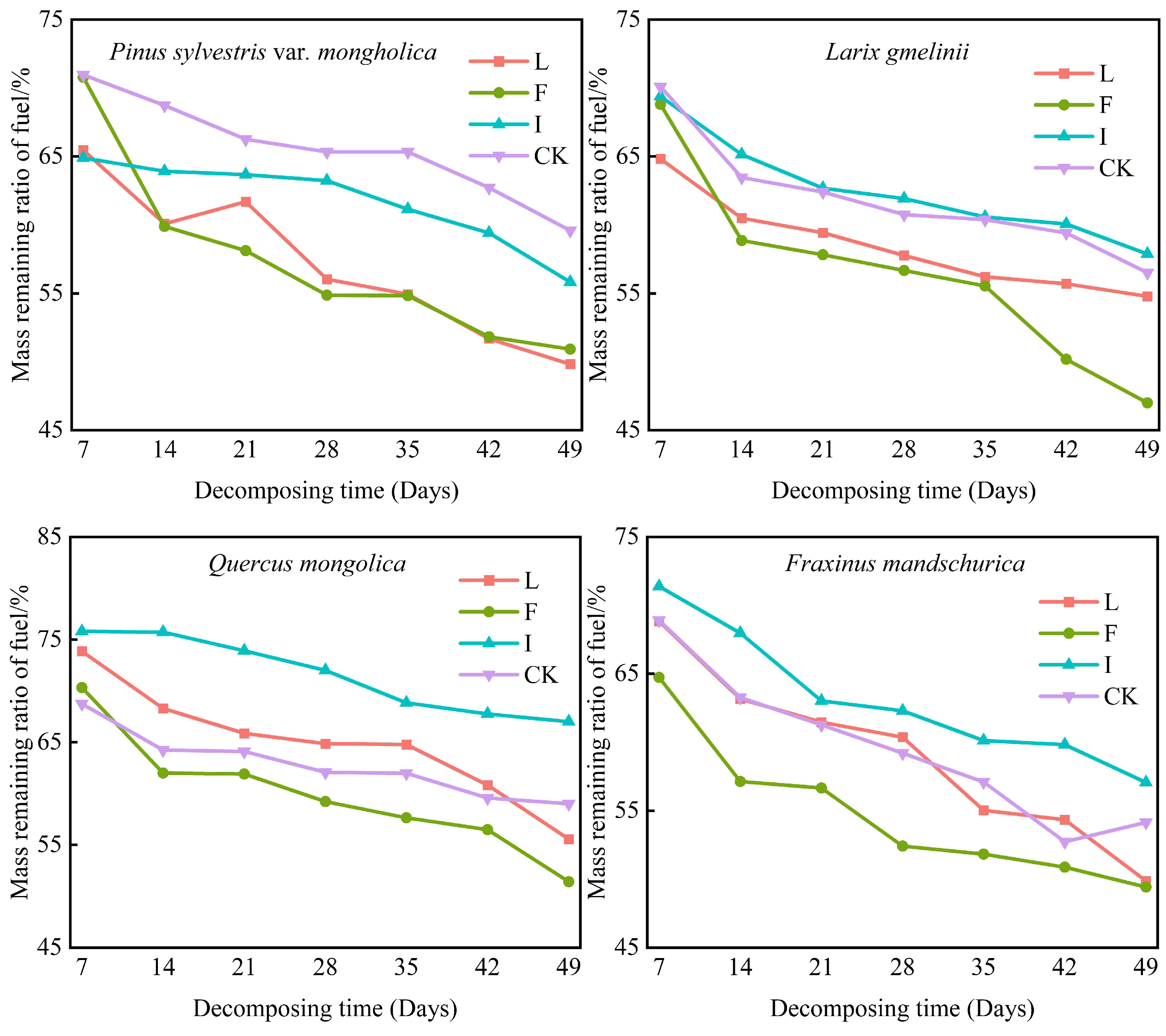
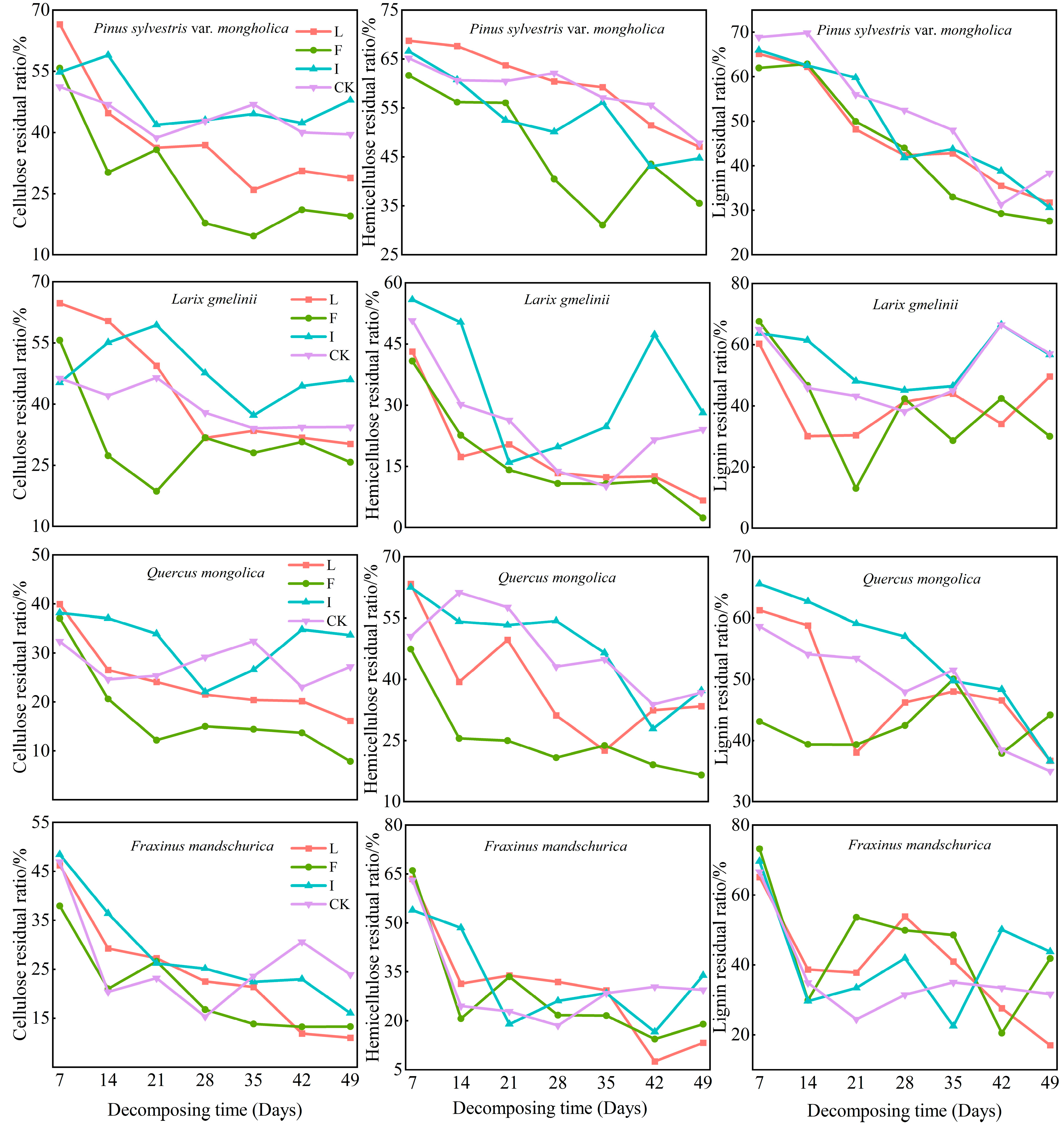
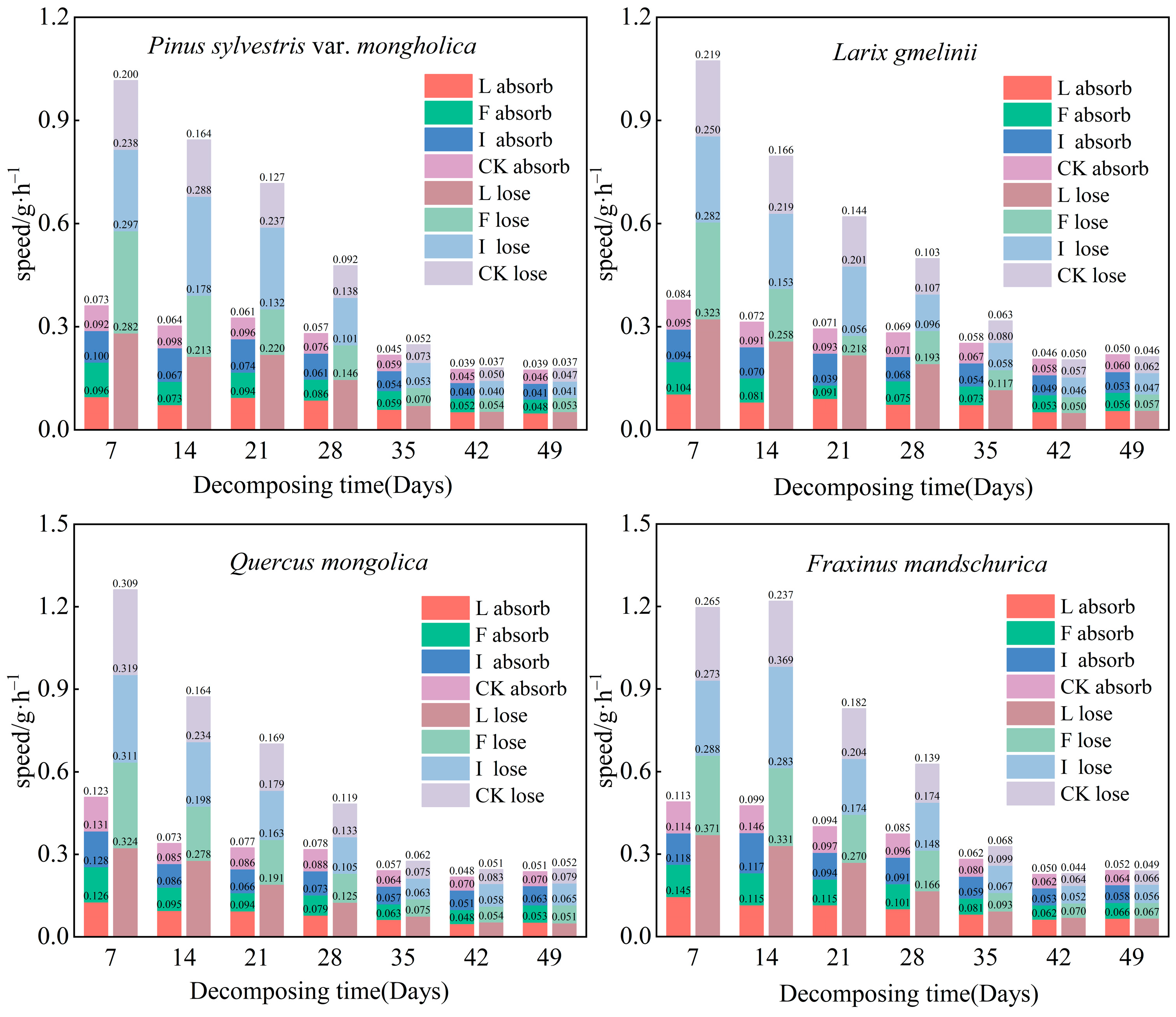
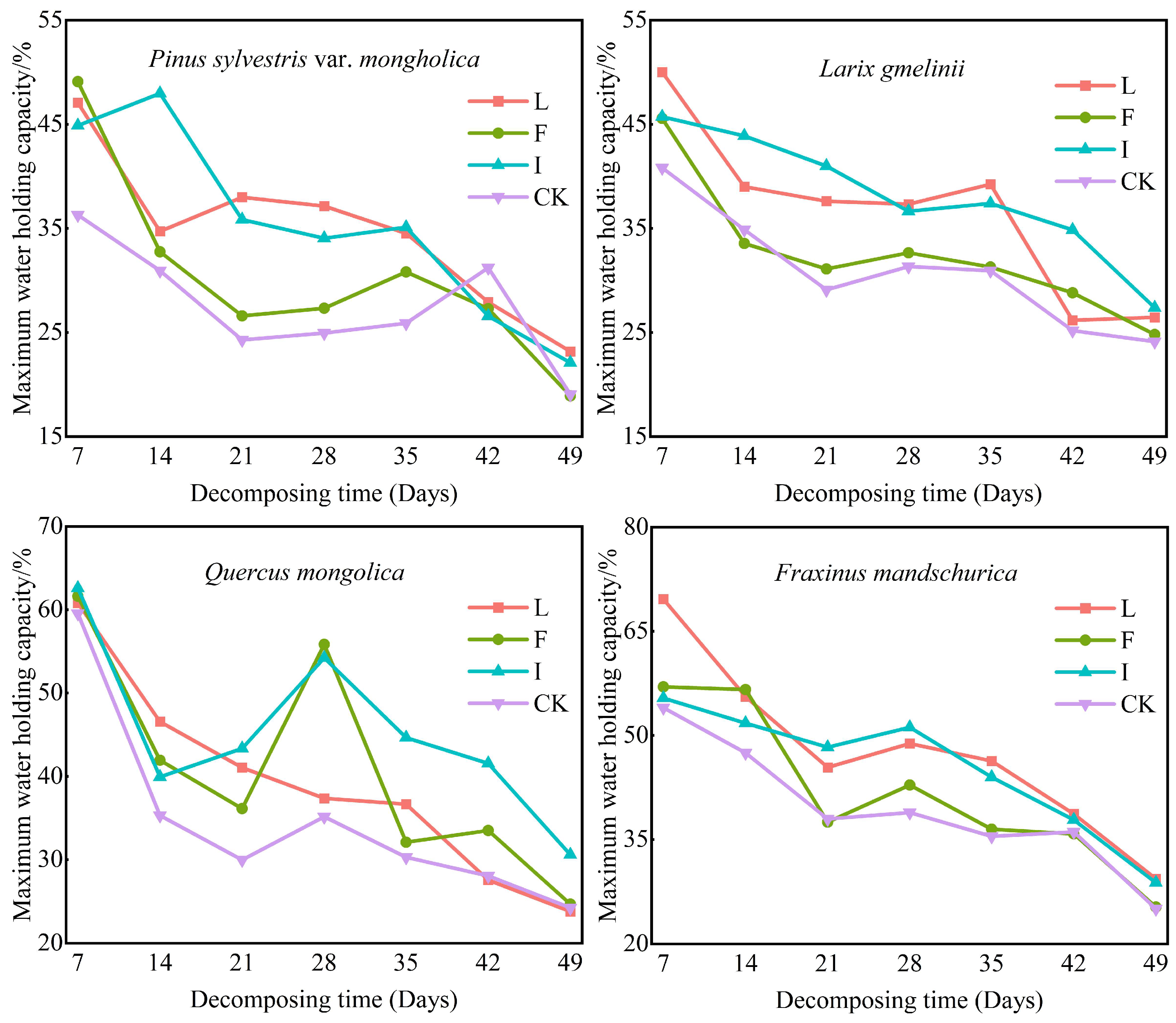
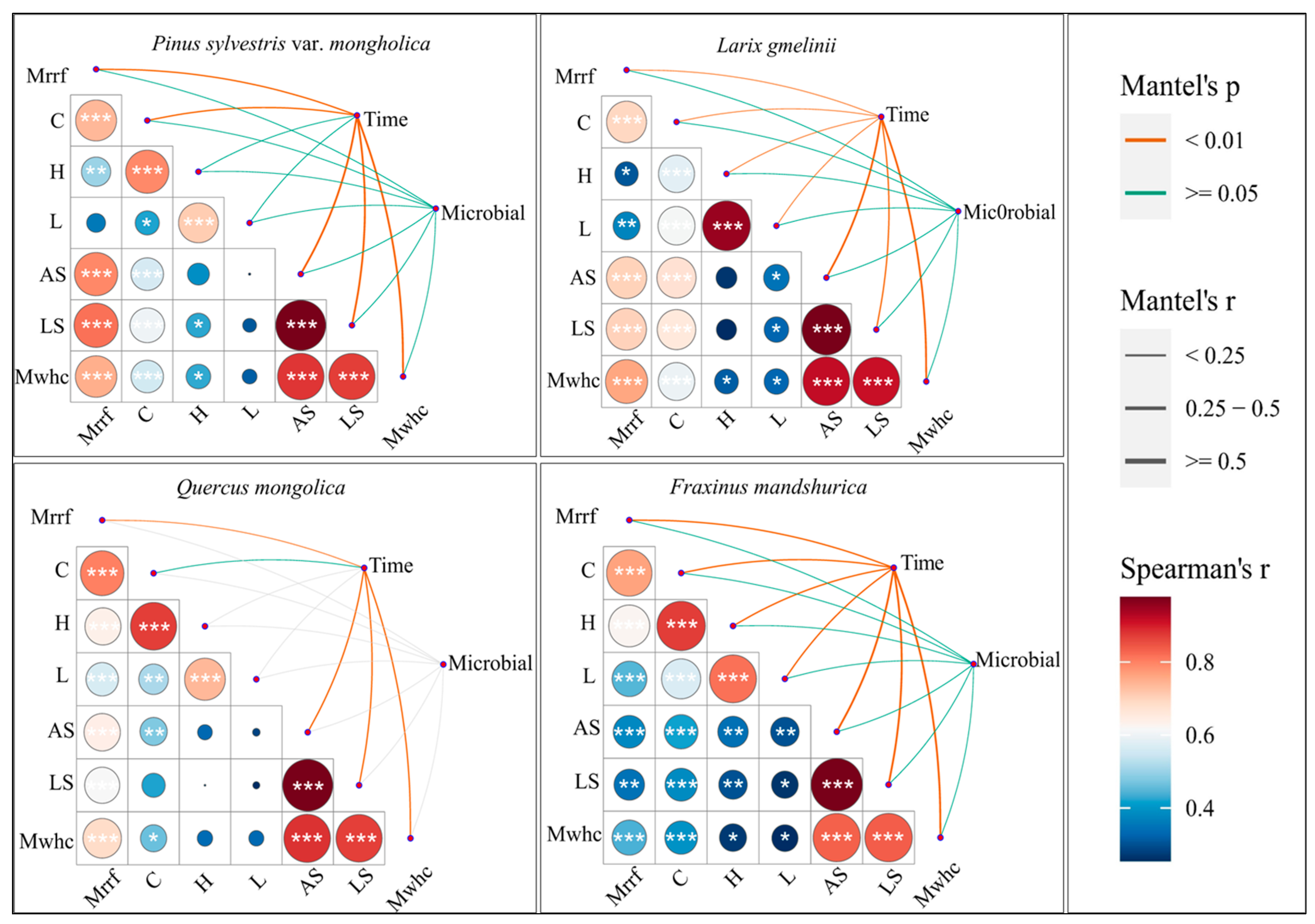
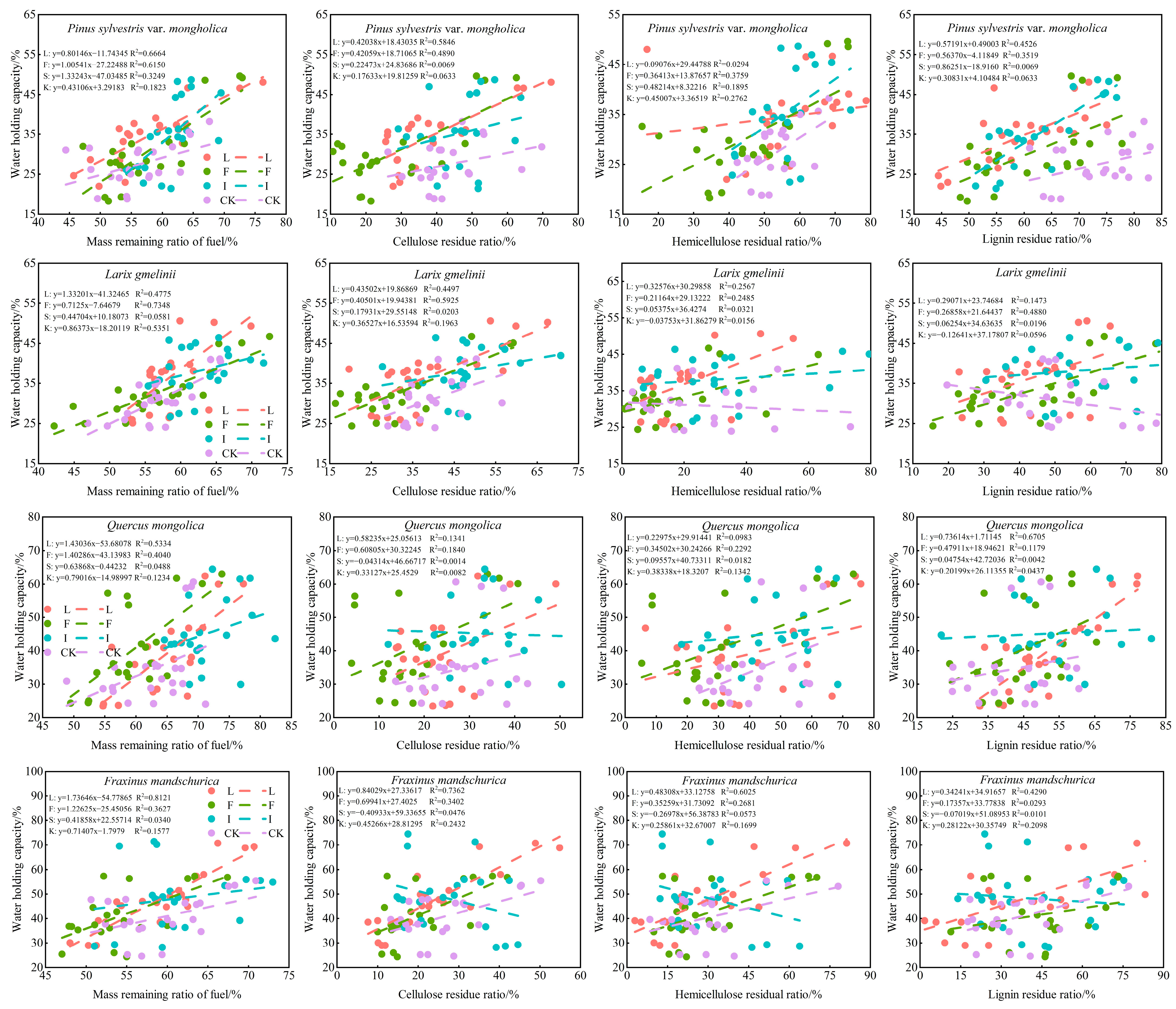
| Fuel Tree Species | Physical and Chemical Properties of Fuel | Mean Value | Minimum Value | Maximum Value | Percentile Value | ||
|---|---|---|---|---|---|---|---|
| 25 | 50 | 75 | |||||
| Pinus sylvestris var. mongholica | Mass remaining ratio of fuel/% | 58.29 | 48.41 | 72.26 | 53.54 | 57.20 | 62.60 |
| Cellulose residual ratio/% | 39.43 | 15.73 | 67.42 | 28.94 | 38.23 | 48.04 | |
| Hemicellulose residual ratio/% | 48.42 | 31.43 | 68.56 | 40.77 | 57.14 | 62.71 | |
| Lignin residual ratio/% | 55.04 | 26.76 | 69.85 | 35.25 | 59.73 | 63.67 | |
| Speed of water absorption/g·h−1 | 0.066 | 0.037 | 0.102 | 0.047 | 0.060 | 0.076 | |
| Speed of water loss/g·h−1 | 0.131 | 0.036 | 0.300 | 0.051 | 0.101 | 0.196 | |
| Maximum water-holding capacity/% | 31.95 | 18.27 | 49.59 | 25.41 | 31.06 | 35.86 | |
| Larix gmelinii | Mass remaining ratio of fuel/% | 58.57 | 46.21 | 70.48 | 55.44 | 58.36 | 61.61 |
| Cellulose residual ratio/% | 40.36 | 16.34 | 66.33 | 29.92 | 36.87 | 47.14 | |
| Hemicellulose residual ratio/% | 23.49 | 3.06 | 56.08 | 8.70 | 18.47 | 29.83 | |
| Lignin residual ratio/% | 33.49 | 13.06 | 68.98 | 24.74 | 47.34 | 56.72 | |
| Speed of water absorption/g·h−1 | 0.069 | 0.039 | 0.105 | 0.054 | 0.069 | 0.081 | |
| Speed of water loss/g·h−1 | 0.133 | 0.045 | 0.800 | 0.057 | 0.096 | 0.198 | |
| Maximum water-holding capacity/% | 34.54 | 23.94 | 50.60 | 28.57 | 34.13 | 39.07 | |
| Quercus mongolica | Mass remaining ratio of fuel/% | 64.78 | 52.84 | 78.38 | 58.83 | 65.66 | 68.92 |
| Cellulose residual ratio/% | 25.38 | 7.94 | 40.35 | 18.24 | 24.23 | 33.19 | |
| Hemicellulose residual ratio/% | 42.28 | 15.37 | 63.56 | 26.58 | 34.48 | 54.49 | |
| Lignin residual ratio/% | 51.29 | 36.13 | 65.57 | 39.17 | 48.35 | 59.92 | |
| Speed of water absorption/g·h−1 | 0.078 | 0.045 | 0.133 | 0.060 | 0.073 | 0.087 | |
| Speed of water loss/g·h−1 | 0.146 | 0.050 | 0.330 | 0.064 | 0.123 | 0.194 | |
| Maximum water-holding capacity/% | 39.96 | 23.51 | 64.50 | 30.36 | 36.51 | 45.55 | |
| Fraxinus mandshurica | Mass remaining ratio of fuel/% | 59.09 | 50.02 | 72.99 | 53.79 | 58.81 | 62.52 |
| Cellulose residual ratio/% | 24.77 | 12.64 | 48.48 | 15.52 | 20.98 | 31.13 | |
| Hemicellulose residual ratio/% | 30.43 | 7.96 | 67.24 | 17.75 | 24.06 | 35.44 | |
| Lignin residual ratio/% | 40.26 | 18.69 | 73.23 | 25.35 | 35.74 | 49.92 | |
| Speed of water absorption/g·h−1 | 0.089 | 0.049 | 0.147 | 0.062 | 0.064 | 0.108 | |
| Speed of water loss/g·h−1 | 0.167 | 0.043 | 0.376 | 0.066 | 0.146 | 0.253 | |
| Maximum water-holding capacity/% | 44.56 | 26.31 | 68.46 | 36.36 | 34.40 | 49.80 | |
Disclaimer/Publisher’s Note: The statements, opinions and data contained in all publications are solely those of the individual author(s) and contributor(s) and not of MDPI and/or the editor(s). MDPI and/or the editor(s) disclaim responsibility for any injury to people or property resulting from any ideas, methods, instructions or products referred to in the content. |
© 2024 by the authors. Licensee MDPI, Basel, Switzerland. This article is an open access article distributed under the terms and conditions of the Creative Commons Attribution (CC BY) license (https://creativecommons.org/licenses/by/4.0/).
Share and Cite
Yang, G.; Li, B.; Liu, X.; Wang, L.; Zhang, Y.; Ning, J.; Zhao, F.; Wang, M.; Yu, H. Effect of Microbial Degradation Treatments on Lignocellulose, Cellulose, and Water-Holding Capacity of Four Typical Forest Fuels from Northeast China. Fire 2024, 7, 301. https://doi.org/10.3390/fire7090301
Yang G, Li B, Liu X, Wang L, Zhang Y, Ning J, Zhao F, Wang M, Yu H. Effect of Microbial Degradation Treatments on Lignocellulose, Cellulose, and Water-Holding Capacity of Four Typical Forest Fuels from Northeast China. Fire. 2024; 7(9):301. https://doi.org/10.3390/fire7090301
Chicago/Turabian StyleYang, Guang, Baozhong Li, Xinye Liu, Lixuan Wang, Yunlin Zhang, Jibin Ning, Fengjun Zhao, Mingyu Wang, and Hongzhou Yu. 2024. "Effect of Microbial Degradation Treatments on Lignocellulose, Cellulose, and Water-Holding Capacity of Four Typical Forest Fuels from Northeast China" Fire 7, no. 9: 301. https://doi.org/10.3390/fire7090301






